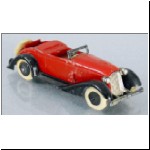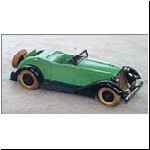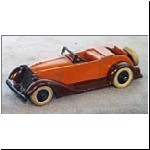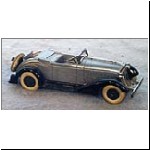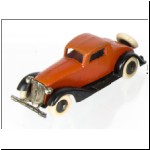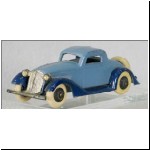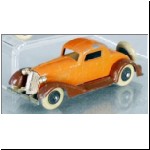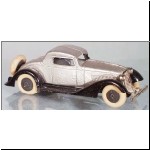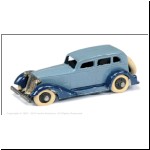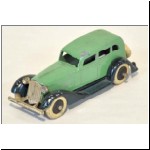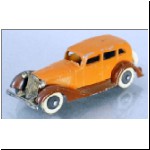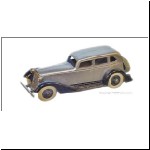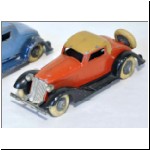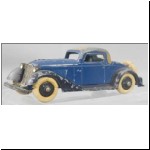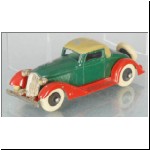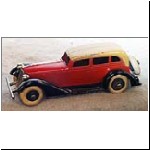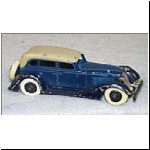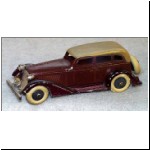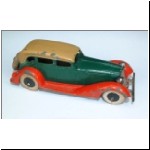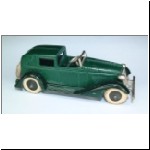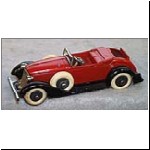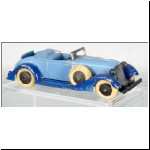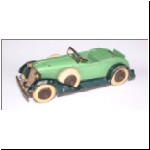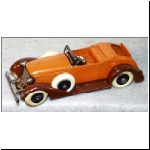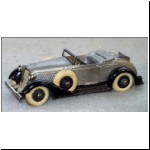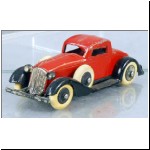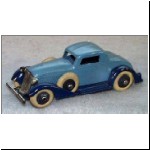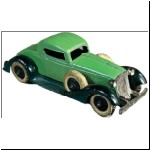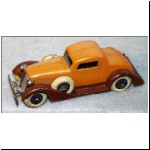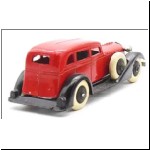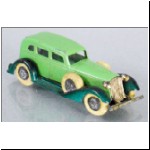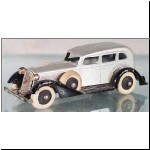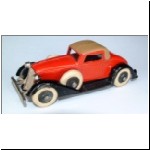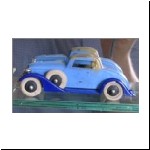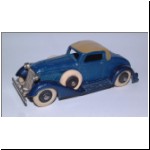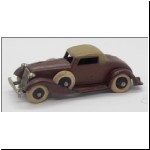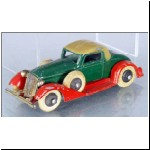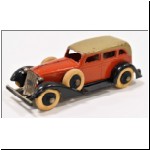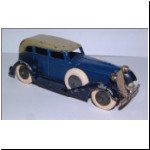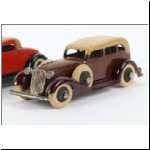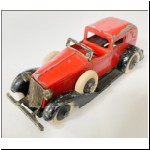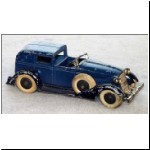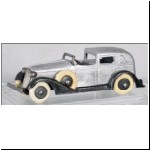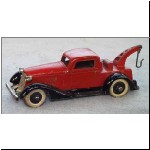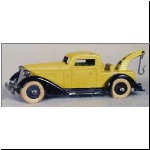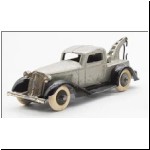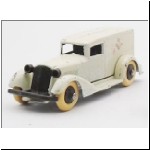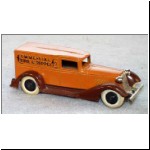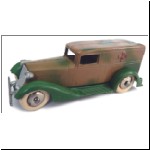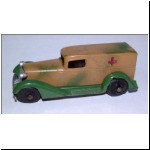|
A History of Pre-War Automotive
Tootsietoys
by Clint Seeley edited by Robert Newson Part 5 - Grahams, new Mack trucks and other 1933 issues Clint Seeley's original text is in green, and my editorial additions are in blue. Put your mouse over the thumbnail images to see the picture caption, and click on the thumbnail to enlarge. The year 1933 saw the world-wide depression well advanced, with many industries facing financial disaster, national economies continuing to decelerate, and world politics entering a period of transition and growing central power, often at the expense of individual and corporate freedom. While the nation and the world were confronted by the gloomy downward spiral of their economies, in Chicago the makers of a popular ten-cent toy were enjoying ever better annual sales figures, as the demand for more expensive toys diminished. Indeed, the 1933 catalogue of the Dowst Manufacturing Co. was the most opulent and inclusive of the entire series. By that time the firm had been in business in one form or another for more than half a century, and in the business of making small die-cast metal toys for a generation. They had invented the die-cast miniature (not strictly true - see part 7 of this article) and had compiled an impressive list of firsts, though they may not have been aware of the historical significance at the time. With so rich a tradition of innovation, it should have been no surprise that the 1933 catalogue would introduce several further novelties. Rubber tyres made their bow, being standard on new issues and made available as options on earlier models still available with metal disc wheels. Models with rubber tyres were designated by catalogue numbers beginnlng with 0, this figure being added as a prefix to rubber-shod versions of older numbers. Where rubber tyres were an option, this is indicated in the listing (parts 8 & 9 of this article). The 1933 catalogue:  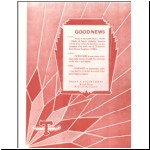 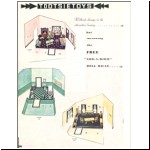 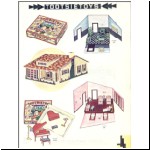   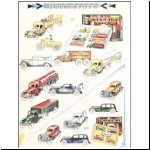   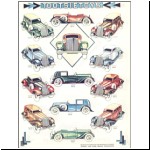 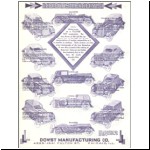 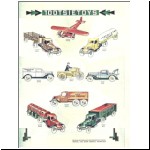 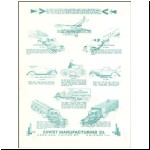 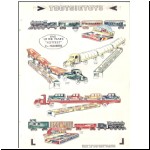     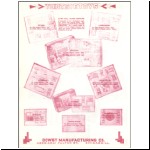       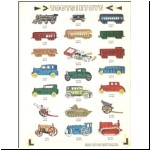 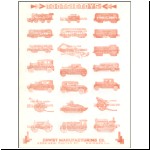 A colour reproduction of this catalogue was published in 1989: http://www.amazon.co.uk/1933-Tootsietoy-Catalog-Reproduction-Price-Guide/dp/9999980112 Another change was the substitution of the harder zinc alloy called Zamak for the older lead formula. This resulted in a much stronger casting, but led to a problem of slow oxidation if there was any lead contamination in the metal. When this occurred, a gradual expansion and disintegration took place, often miscalled "metal fatigue", an all too familiar phenomenon. This malady afflicted relatively few Tootsietoys made for a few years after the changeover, and has not been the catastrophic epidemic that has wiped out so many of the Dinky and Marklin toys of the same era. I do not know the source of the problem in Europe, but at Dowst it usually happened this way: when lead alloy had been the order of the day, employees often tossed scraps of foil into the melting pot, and many a crumpled liner from a tobacco package lies hidden harmlessly in older lead toys. When this habit carried over into the age of Zamak, it was a different matter, and the seeds of ultimate destruction were sown. The firm became aware of the problem after a year or two and discouraged the practice. Prior to that it was sheer chance if a batch got through safely, but most later old Tootsietoys are as sound today as when made over thirty years ago. The problem recurred when metals became scarce just before and during the Second World War. l am told that it is safe to assume that a casting is essentially lead-free if it appears sound by the time it is about ten years old, but the rapidity of disintegration seems to be proportional to the amount of contamination. So don't panic and dispose of healthy old Dlnkies in fear that the future may kill them. Tootsietoy Grahams
The
new models in 1933 showed a greater sophistication of design, and a
greater accuracy of line, proportion and detail, both in the new Macks
and the most famous Tootsietoys of all, the 1932 Grahams. Graham was an American brand of motor
cars that started in 1927, when the Paige-Detroit Motor Car Company was
acquired by the Graham brothers. Their 1932 'Blue Streak' models
introduced several design innovations and were an immediate
success. No doubt these stylish cars caught the attention of
Tootsietoy, who built on the idea from their General Motors series of interchangeable bodies on a
common
chassis. Not only were there
different body styles, but inserts in the dies were used to create
variations of the spare wheels (twin side-mounted, rear-mounted or no
spares) and to produce the van with two different types of lettering on
the sides, or as an ambulance. It is notable that initially
Tootsietoy
did not use the Graham name on the models or in catalogues - perhaps they were negotiating a fee
for this
publicity from the car manufacturer? Only from the 1934 price
list were the models identified as Grahams.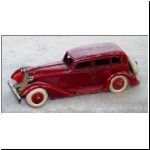  There was a special promotional version of the Graham sedan, probably for Graham dealers, shown in these two photos. Note the coloured wheel hubs on this model, the metallic paint (like the real cars) and the box lettering in Graham's house style. A new catalogue numbering system was also introduced with the Macks and Grahams, a bit too complex to detail here. Careful study of the comprehensive list at the end of this series (or the table of photos below) will unlock the mystery. The rows of photos above show the twelve variations of the Graham cars that were catalogued individually. "Convertible" models were merely the same castings as closed models, but with their tops painted khaki, often resulting in a three-toned colour scheme. No Graham passenger cars were ever shown without spare wheels except in boxed sets (see below), so the fact that many such models exist is a small mystery. (Not really - Tootsietoy sold a lot of sets!) Also, as different colours were used in later years in some instances, the ratios in which they were boxed for wholesale marketing (see page 10 of the 1933 catalogue above) do not seem to hold up in surviving collections. Pictured in the rows above are the standard colours for each model as mentioned in the 1933 catalogue. The roadster and the regular (non-convertible) sedan and coupe came in red with black chassis, light blue with dark blue chassis, light green with dark green chassis, or orange with brown chassis. Confusingly, the catalogue calls the orange colour 'yellow'. The town car was red with black chassis, dark blue with darker blue chassis, or dark green with darker green chassis. The convertible sedan and coupe came in red with black chassis, light blue with dark blue chassis, brown with maroon chassis, or dark green with red chassis, but the light blue versions were soon replaced by a dark blue body and darker blue chassis (as on the town car). Shades of the khaki top can vary to a tan colour. Also pictured above are the later silver and black colours found on the Graham sedan, coupe, roadster, town car and wreck truck. 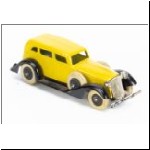 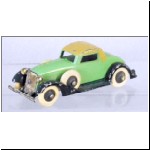  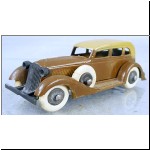 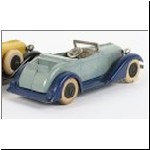 Philippe de Lespinay's website had much interesting additional information on the Tootsietoy Graham and La Salle colour and casting variations, but unfortunately seems no longer to be online. This link will take you to an archive of one of his pages with (at the end) a list of colour variations on each model. Philippe also described the yellow and black sedan with twin spares that only came in the 'Tootsietoy De Luxe Motors' set (see photo above, and other examples in the boxed sets pictured below). This had a true yellow colour body. He judged it to be the most common colour scheme for the regular six-wheel sedan. Examples also exist of convertible models in the two-tone green colour scheme, and in a different shade of brown from previously with the body and chassis in the same colour. The last photo in the row above shows a light blue/dark blue roadster with no spare wheels, presumably a late version (1936 or 1937) from a set, although I am not sure exactly which one. Some sedans and coupes with no spares were also issued around that time - see examples pictured in sets below. 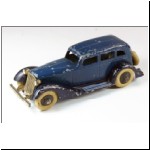 A rare
sedan is pictured here in the dark blue/darker blue colours usually
found on convertible models, but without the khaki roof. This may
be more in the nature of a factory error rather than an intentional
colour scheme. A rare
sedan is pictured here in the dark blue/darker blue colours usually
found on convertible models, but without the khaki roof. This may
be more in the nature of a factory error rather than an intentional
colour scheme.If you can contribute photos of any genuine original colour variations not pictured, please e-mail me.  A notable casting variation occured
on the roadster, where earlier models had an open area surrounding the
dicky seat, which was later filled in so that the dicky seat area has
solid walls. A notable casting variation occured
on the roadster, where earlier models had an open area surrounding the
dicky seat, which was later filled in so that the dicky seat area has
solid walls.It is a curious phenomenon that the later Grahams and other models from the second half of the 1930s had plated grilles that over time have turned completely black, even on pristine models in boxed sets (see some examples further down the page). The problem was solved on the Graham Army Ambulance (from 1939) by using silver paint on the grille.
The Graham commercials were given numbers in sequence with the new Mack trucks, segregating them from the passenger cars. The Ambulance was added to the range in 1935. The 'Commercial Tire' van was not numbered, as it was only available in boxed sets 5300 'Tootsietoy De Luxe Motors' (1935) and 5360 'Bild-a-Car' (1938-9). The twelve variations of the Graham cars were catalogued individually from 1933 to 1936. After that, the cars were only available in the Bild-a-Car set, and briefly in Playtime Toys set no.05050 (see below for details). The Wrecker, Dairy Van and Ambulance were last in the catalogue in 1938, but the Ambulance continued in Army Set no.5220 from 1939 to 1941, and was also available singly in 1941 in camouflage finish. The camouflaged Ambulance was the last Graham in production, and was cast in lead due to the wartime shortage of zinc - somewhat ironic as the Grahams had been among the first models to replace lead with zinc in 1933. Some of these Ambulances had solid black rubber wheels, and according to Philippe de Lespinay were re-issued in 1945, but the model was not in any post-war catalogue or price list that I am aware of. The Tootsietoy
Bild-a-Car Set
Multiple colour combinations were made possible in the 'Bild-a-Car' sets, in which five bodies and five chassis were interchangeable by means of divided axles, held by clips in the centre. The set was catalogued from 1933 to 1939. 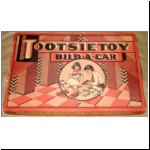 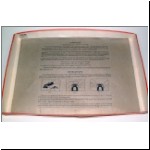  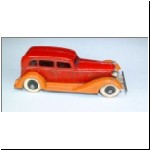 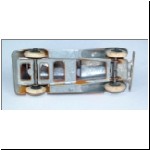
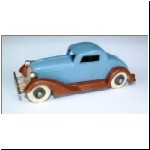  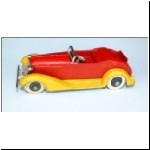  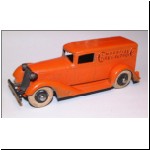  From 1938 the 'Commercial Tire' van replaced the roadster. 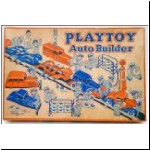 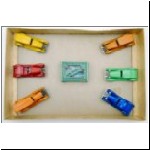 The photos left show a Bild-a-Car set boxed as 'Playtoy Auto Builder', with no Tootsietoy branding. Possibly this was done for a chain store or mail-order company. The box insert is missing. Assuming the contents pictured are original, there was one extra model in the set (six Grahams rather than five) with both the 'Commercial Tire' van and the roadster included.  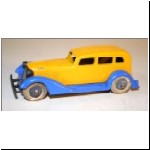   The Bild-a-Car set was given new box
artwork for
1938, and the contents were re-arranged. Probably in 1939, the
models were given unpainted
wheels, like the 1939 version of the
ambulance (but with Bild-a-Car axles and not with blind hubs), see the all-orange sedan
pictured. The Bild-a-Car set was given new box
artwork for
1938, and the contents were re-arranged. Probably in 1939, the
models were given unpainted
wheels, like the 1939 version of the
ambulance (but with Bild-a-Car axles and not with blind hubs), see the all-orange sedan
pictured.  These two auction photos (left) show
a Bild-a-Car Coupe and Sedan with unpainted wheels and silver-painted
grilles. There was no suggestion from the auction house that the
grilles were not original, but it is impossible to tell without
examining the models (and even then it might be difficult!)
However, I think it is very likely that the final version of the set
had silver-painted grilles, like the 1939 ambulance. Discovery of a
complete original set containing models with unpainted wheels and
painted grilles would help to prove the point. These two auction photos (left) show
a Bild-a-Car Coupe and Sedan with unpainted wheels and silver-painted
grilles. There was no suggestion from the auction house that the
grilles were not original, but it is impossible to tell without
examining the models (and even then it might be difficult!)
However, I think it is very likely that the final version of the set
had silver-painted grilles, like the 1939 ambulance. Discovery of a
complete original set containing models with unpainted wheels and
painted grilles would help to prove the point.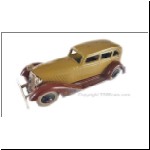  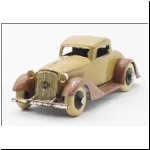 The sedan and coupe with khaki bodywork and brown chassis were issued in the Bild-a-Car set, but can also be found with full axles, suggesting that they also appeared in other set(s). Other Gift sets
containing Tootsietoy Grahams
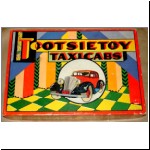   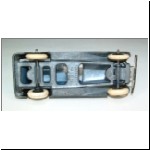 The Taxicabs set (no.5350) was
produced from 1933 to 1937, at first containing four Graham sedans and
one Wreck Truck. The sedans had no spare wheels, but always had
full axles, rather than the
divided axles of the Bild-a-Car models. In the final version of
the set, the Grahams were replaced by Doodlebugs (see photo in part 6). The Taxicabs set (no.5350) was
produced from 1933 to 1937, at first containing four Graham sedans and
one Wreck Truck. The sedans had no spare wheels, but always had
full axles, rather than the
divided axles of the Bild-a-Car models. In the final version of
the set, the Grahams were replaced by Doodlebugs (see photo in part 6).   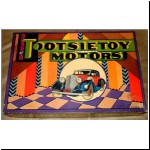  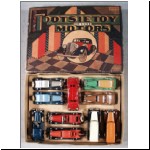 The Tootsietoy De Luxe Motors set
contained ten Graham models. It was produced from 1933 to 1935,
and was available in two box styles. The more compact version was
numbered 0530X, the 'X' in the catalogue usually indicating a
discontinued
line, although the set was in the price list throughout 1933 to
1935.
Probably it continued to be a good seller, as both the shipping weight
and wholesale price were a little lower than the larger set. The
version with a larger box was no.05300. In 1935, the 'Commercial
Tire' van was added to the set, replacing one of the roadsters, and the
final version replaced some of the Grahams with two of the new La
Salles
and a Doodlebug (see
photo left). The Tootsietoy De Luxe Motors set
contained ten Graham models. It was produced from 1933 to 1935,
and was available in two box styles. The more compact version was
numbered 0530X, the 'X' in the catalogue usually indicating a
discontinued
line, although the set was in the price list throughout 1933 to
1935.
Probably it continued to be a good seller, as both the shipping weight
and wholesale price were a little lower than the larger set. The
version with a larger box was no.05300. In 1935, the 'Commercial
Tire' van was added to the set, replacing one of the roadsters, and the
final version replaced some of the Grahams with two of the new La
Salles
and a Doodlebug (see
photo left).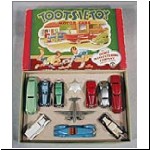 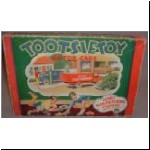 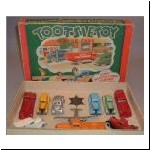 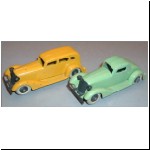 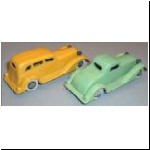 The De Luxe motors set was replaced in 1936 by the Tootsietoy Motor Cars set no.05200. This set contained four Grahams, three Jumbos, one La Salle, one Doodlebug, a TWA plane and a six-pointed star badge! Some examples of this set contained a single-colour Graham sedan and coupe wih no spare wheels and Bild-a-Car axles, i.e. they were ready-built examples of the Bild-a-Car models. 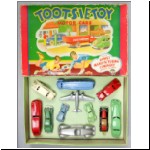 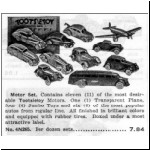 For 1937, the contents of the set were changed while retaining the same box lid. The star badge was dropped in favour of an eleventh model, and according to the Tootsietoy catalogue (and the N.Shure Co. catalogue shown here) the set contained four Jumbos, a La Salle sedan and coupe, a 1935 Ford sedan and coupe, a Lincoln Zephyr sedan and wrecker (without motors), and a TWA plane. The actual example pictured has a Graham coupe instead of the La Salle sedan. 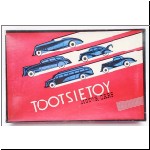 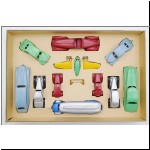 1938 was the last year for this set, when it was given new box art and a Crusader Plane in place of the TWA. Two Lincoln sedans were now supplied in the set, rather than one sedan and one wrecker.  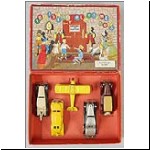  Playtime Toys set no.05050 ran from 1935 to 1937. In its last year, a Lincoln Zephyr and Wings biplane replaced the earlier Doodlebug and Trimotor. Some 1937 sets also included a single-colour Graham sedan with no spares (see the red model in the photo). 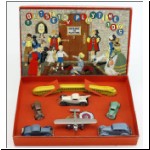 Shown here is the larger Playtime Toys set. no.05075, listed in 1935 and 1936 only. 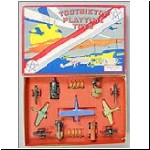 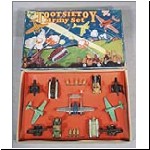 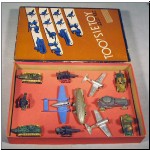 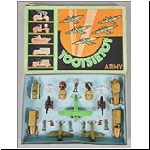 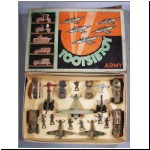 The Army Set no.5220 was catalogued from 1936 to 1941. The contents and box art were regularly updated. The re-vamped set for 1939 gave a new lease of life to the Graham ambulance, painted in Army brown, and in 1941 the model was given a green chassis and camouflaged body. The Graham Wreck Truck and Tootsietoy Dairy van could also be found in various sets containing commercial vehicles. - - - - | - - - -
I am still asked from time to time about certain models which never existed. These include: town car without spare wheels, breakdown truck or panel van with side spares, touring car, station wagon (estate car), and mail van. Any such that you may encounter are the product of choppers, children, or charlatans. There are also many minor variations of castings, involving all parts (body, chassis, grille, wheels), which baffle me and are thus declared beyond the scope of this run-down. Copies of the
Tootsietoy Graham
The design of the
Grahams, having body and chassis castings held together by the axles
and a separate casting for the grille/headlights/bumper, was seminal in
influencing the design of toy cars around the world for the rest of the
1930s. This design was patented in 1934 (see part 4), and Tootsietoy were quick to defend
their patent in the USA with legal action, but this was less
practical in other countries. Tootsietoy's construction method
was copied extensively by Dinky Toys in England and France, and by
other makers in the UK and Europe.      Some manufacturers went further, and
made close copies of the Graham models themselves. In England,
Johillco copied the Graham sedan (always with twin sidemount spare
wheels) and the coupe (always with a rearmount spare). These were
zinc diecast models, with the grille/headlights/bumper incorporated
into the body casting. Raised door shut-lines (rather than
recessed lines on the Tootsietoy) are another recognition
feature. MADE IN ENGLAND was cast underneath. In
Denmark, K.A.Birk & Co. made versions of the Graham sedan, coupe,
van and wreck truck, in lead with a common tinplate chassis and lead
grille. They also put their own designs of bodywork on the
standard chassis, such as the attractive cement mixer pictured
above. An unknown manufacturer (probably also Danish) made the
lead Graham wrecker pictured in the fifth photo. The turned brass
wheel hubs are original, and there is no identification cast on the
model. A similar sedan (with rearmount spare) has also been
seen. The foregoing models were all contemporary copies, i.e.
from the 1930s, but the last photo (left) shows a modern white metal
reproduction of the Graham sedan by Buccaneer (England) from around
1975. This is clearly marked underneath. The vast number of
original Tootsietoy Grahams in the market makes it unlikely that anyone
would bother to make a white metal reproduction these days!
According to Louis Hertz, some 4.2 million Tootsietoy Grahams were
produced, this figure being the known production quantity of the Graham
chassis, presumably from factory records (page 296 in ref.5). Some manufacturers went further, and
made close copies of the Graham models themselves. In England,
Johillco copied the Graham sedan (always with twin sidemount spare
wheels) and the coupe (always with a rearmount spare). These were
zinc diecast models, with the grille/headlights/bumper incorporated
into the body casting. Raised door shut-lines (rather than
recessed lines on the Tootsietoy) are another recognition
feature. MADE IN ENGLAND was cast underneath. In
Denmark, K.A.Birk & Co. made versions of the Graham sedan, coupe,
van and wreck truck, in lead with a common tinplate chassis and lead
grille. They also put their own designs of bodywork on the
standard chassis, such as the attractive cement mixer pictured
above. An unknown manufacturer (probably also Danish) made the
lead Graham wrecker pictured in the fifth photo. The turned brass
wheel hubs are original, and there is no identification cast on the
model. A similar sedan (with rearmount spare) has also been
seen. The foregoing models were all contemporary copies, i.e.
from the 1930s, but the last photo (left) shows a modern white metal
reproduction of the Graham sedan by Buccaneer (England) from around
1975. This is clearly marked underneath. The vast number of
original Tootsietoy Grahams in the market makes it unlikely that anyone
would bother to make a white metal reproduction these days!
According to Louis Hertz, some 4.2 million Tootsietoy Grahams were
produced, this figure being the known production quantity of the Graham
chassis, presumably from factory records (page 296 in ref.5).New Mack Trucks
 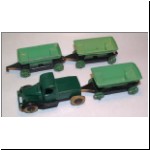         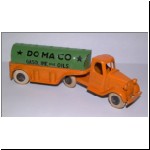 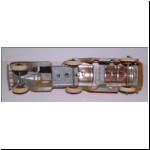   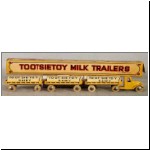     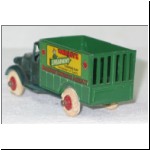 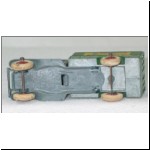      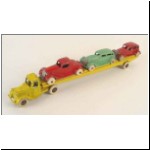 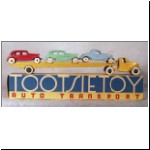 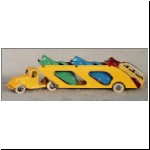 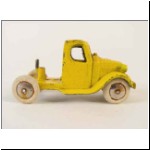  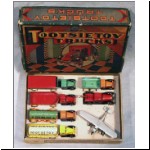 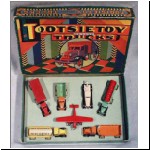 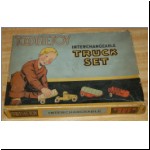 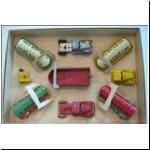 The other major feature of the year was the new, larger, Mack truck series. These featured closed cabs, headlamps, and well-defined bumpers and running boards. During the first few years they were made with separate cab and chassis castings and were fitted with dual rear tyres on both tractor and semi-trailer. These were replaced in 1936 by one-piece tractors and single rear wheels. Some half-way hybrids were apparently sold during the period of change-over (see the photo of the CITY FUEL truck above, also note the patent numbers added to the first-type chassis). The tractor for the dumper train never had dual tyres, and remained the first type two-piece casting until discontinued in 1941. The LONG DISTANCE HAULING closed cargo semi-trailer was discontinued after 1936, so is seldom seen in the second type. (Does it actually exist? Please e-mail me if you have evidence of this version!) The CITY FUEL COMPANY coal truck was issued in a handsome ten-wheeled version in 1933, but reduced to four wheels in 1936 and dropped after 1938. The economy version must have been a sales dud, as one is seldom so unlucky as to gaze upon this ugly descendant of the handsome first version; like the roc, it is a rara avis which only the most devoted purist is happy to find. The oil tanker carried the fictional DOMACO oil company name - a contraction of Dowst Manufacturing Company. The TOOTSIETOY DAIRY tanker was issued in dual-wheeled semi-trailer form, and was also available with two full trailers hooked behind the semi-trailer and with no dual wheels on this version (neither on the tractor nor the trailers). The RAILWAY EXPRESS AGENCY van with the Wrigley Gum decals on the sides was the popular introduction of 1935, changing to the second type casting the following year (both had single rear wheels). On the second type, there was also a small change in the body casting, a horizontal crossbar being added to the vertical slats of the gate at the rear. The car transporter was the first type casting only in its first year, 1935, loaded with 1934 Fords. This is now a rare creature, and I've never seen one intact, though I have seen one of the tractors. I have been luckier than Clint and have a complete example, pictured above, which came with 1935 Fords, believed to be original. The tractor is identifiable by a higher coupling post than the other Mack tractors, and also by the single rear wheels and yellow chassis. It changed to the second type, carrying 1935 Fords, in 1936. It changed form again in 1941, when the stamped tin rear was redesigned to carry three up-tilted cars of the 1940 "230" series. The high trailer with forward overhang required another modification of the coupling post, there being a backward bayonet offset to allow clearance between trailer and cab upon making sharp turns.    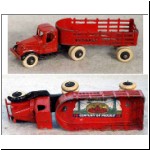    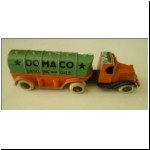 These pictures show
special issues produced for sale at the Chicago World's Fair in 1933. These pictures show
special issues produced for sale at the Chicago World's Fair in 1933. 1933 was also the only year in which the GM series cars were issued in the "no-name" version, the whole GM line dropping from the catalogue the following year. These continued to be cast in lead rather than zamac, as was true of most of the other hold-overs. The older dies probably continued to be used with lead for some technical reason, possibly related to the higher temperature of molten zinc. The desire to wind down lead casting may also explain why so many older numbers were discontinued after 1933. Thus, we bring to a close the chapter dealing with the prolific year of 1933, which surely must go down as the high point in diversity and innovation. ln the following parts we will go on to discuss the 1934 and 1935 Fords, the "Jumbo" or "Torpedo" series, the La Salle/Lincoln/Doodlebug group and a few related pieces. References (5) The Complete Book of Building and Collecting Model Automobiles by Louis H.Hertz, Crown Publishers Inc., New York, 1970. |
© Robert Newson
